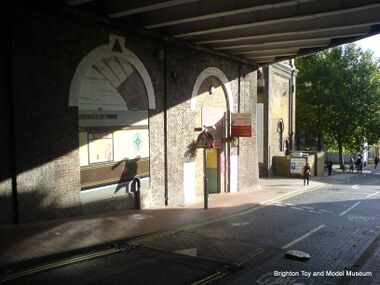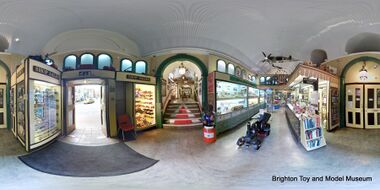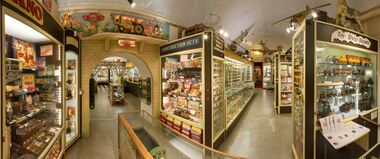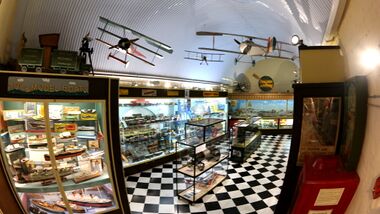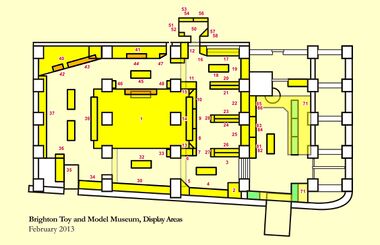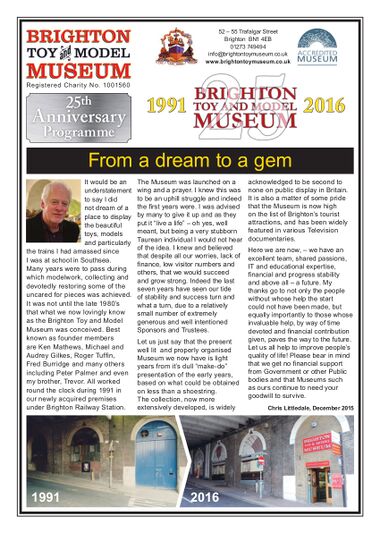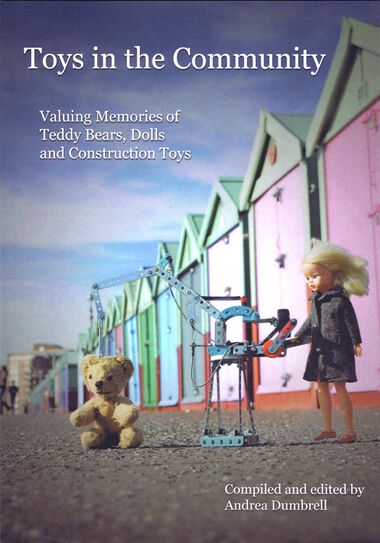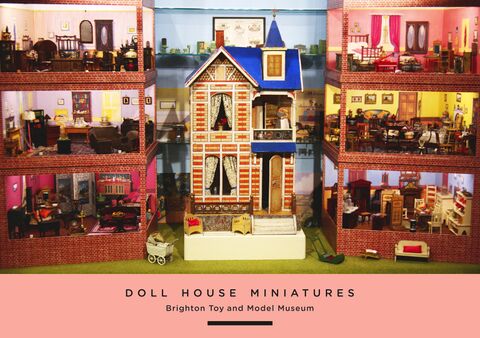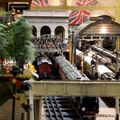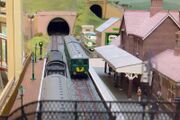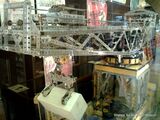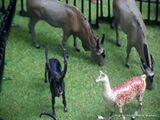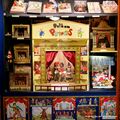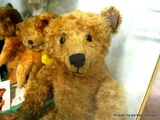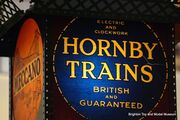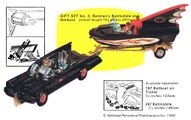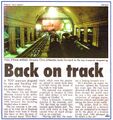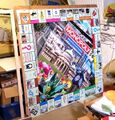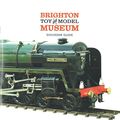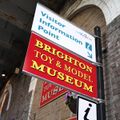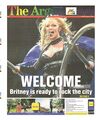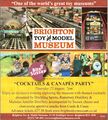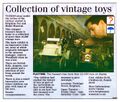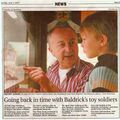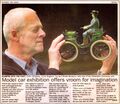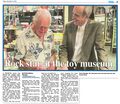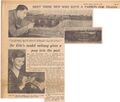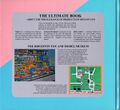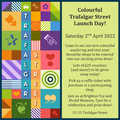Category:Brighton Toy and Model Museum
Flower baskets outside the museum, August 2011 [image info]
Entrance and second arch of Brighton Toy and Model Museum, shadowed [image info]
Museum lobby, 360-degree panoramic view. The main museum area is up the set of steps in the centre. Standard wheelchairs can be accommodated via a second entrance [image info]
Arch Two [image info]
Arch Four [image info]
Museum layout [image info]
Charity Registration Certificate 1001560 [image info]
The Museum celebrates its 25th anniversary in 2016 [image info]
2016: Front cover of the "Toys in the Community" book, produced in 2016 [image info]
Set in a series of Victorian railway arches underneath Brighton Station, Brighton Toy and Model Museum is one of the World's key centres of excellence for the preservation and display of toys and models, focusing on the golden age of British and Continental toymaking from the first to the fifth decades of the Twentieth Century.
The 25th Anniversary
2016 was the 25th anniversary of the museum, which first opened its doors in 1991. While 2015 was spent focusing on general infrastructure improvements, 2016 was marked by some significant improvements and additions to the displays and collections.
Enhancement and display policy
The museum has a policy of continuous improvement, with important new exhibits being added and new display spaces being created in nooks and corners of our limited space, practically on on a month-by-month basis. The density of the exhibits means that labelling needs to be minimal ... but to compensate for this we invest heavily in producing online contextual material – catalogue images, advertising and other promotional and background material on the exhibits.
This archive material is viewable online for everyone, and has become a world-class resource. It's also available within the museum via a free wifi connection on the Museum tablets, and also on visitors' own devices, supported by QR code links and NFC "swipe" points.
Inside the Museum
- Display areas - our displays and display areas
- Museum exhibits - the first ~sixteen hundred individual display items to be listed. This list is constantly being expanded.
- Director's Choice - Exhibits and displays selected by the Director, Chris Littledale, as having special significance.
Toy periods
Nineteenth Century
By the mid-C19th, the industrial revolution had changed most other aspects of how we worked, travelled and lived, and the idea of having workshops equipped with machine tools started to be applied to toymaking.
A range of toymaking companies emerged in Southern Germany, the biggest being Bing and Märklin, who dominated the World market for metal toys. The end of the C19th saw model engineering emerging as an increasingly serious hobby.
1900-1914
The years up to World War one saw a rapid growth on toymaking sophistication, the appearance of Meccano as the first mass-market construction set (other than Anchor Blocks), the rapid growth of Bassett-Lowke, and the birth of the teddybear.
1918-1939
During this period, Britain saw an explosion in metal toymaking as local companies found that they could now enter a market (metal toys) previously dominated by the German toymaking giants. It also saw an influx of toymaking talent from the Continent as political instability abroad prompted a wave of skilled émigrés and refugees looking for the comparative political stability of the UK. As production shifted further from wood to metal, the industry shifted from producing individually hand-carved pieces created by unnamed partworkers and local carpentry workshops, to the use of highly-promoted brandnames and modern factory production. Talented and creative toy designers of the period could now see their works being sold and promoted to a wider audience, and great toy design became something that could transmute a simple piece of low-tech printed and folded tinplate or a lump of painted lead into a mass market product. The Golden Age saw the appearance of ever-more-sophisticated gauge 0 model railways, the birth of the half-size modern 00-gauge, and the invention of diecast toys using in the new alloy, MAZAC.
1945-1960
The metal age was followed after WW2 by the emergence of new plastics, which undercut metal production. Hilary Page's plastic brick design for Kiddicraft was "borrowed" by Lego, Dinky Toys' dominance of the diecast market was undercut by newcomers Corgi and Spot-On, and television and film spin-offs became more lucrative.
Post-1960
The mass-production of plastics and often resulted in an emphasis on lower production costs rather than on design excellence. There were exceptions, but increased internationalisation and a downward pressure on prices meant that a number of the traditional toy companies folded and their brands became passed from company to company. Design decisions were increasingly no longer focused in local workshops or national factories, but with international corporations, whose centralised design meant that toys increasingly became designed for a global market - UK's "Action Man" was a localised version of the American "G.I. Joe" toys, and while the wave of Star Wars merchandise in the 1970s was obviously founded on world-class art and production design, the resulting toys were essentially the same across all international markets.
Plastics were followed by the appearance of embedded electronics, then by video games and home computers and mobile games consoles, then by completely software-based games, and finally (post-2000) by mobile "apps".
Historical focus
While each of these periods has their stand-out examples, finite display space means that the Museum usually focuses on toys and models produced up until about 1955 - this provides the best balance between the proliferation of unsourceable "workshop toys" before 1900, and the strong internationalisation of the toy market that characterised the later Twentieth Century. This period starts when road travel was predominantly by horse, ends in the Atomic Age, and includes two World Wars. It also includes toys that reflected the visionary technological optimism of the 1930s, before this was cruelly cut down by the outbreak of World War Two.
For us, this represents the most individualistic period of toy production, with pieces often hand-engineered by craftsmen and women that tell real stories about social history and change, and design and industrial development, both locally and internationally.
Some popular exhibits
Past events and exhibitions
- Frank Hornby Week - 11th May, and 14-19th May 2013.
- Coronation Scot - our 2012 exhibition on Britain's streamlined, speed-striped Art Deco bullet-train.
Other online resources
- The Museum's main website is at https://www.brightontoymuseum.co.uk/
- The Museum's LinkedIn page is at https://www.linkedin.com/company/brighton-toy-and-model-museum
- The Museum's Google Open Gallery is at http://brighton-toy-and-model-museum.culturalspot.org
- The Museum's Twitter account is at http://twitter.com/thetoymuseum/
- The Museum's Information System is here, at https://www.brightontoymuseum.co.uk/index/
- The Museum's news blog is at http://brightontoyandmodelmuseum.blogspot.com/
- The Museum's YouTube videos are at http://www.youtube.com/user/brightontoymuseum/
Subcategories
This category has the following 21 subcategories, out of 21 total.
2
C
- Children's Play Days (2 P, 12 F)
- Collectors Market (12 F)
D
E
F
- Frank Hornby Week (4 P, 5 F)
H
- History of Brighton Toy and Model Museum (2 P, 9 F)
M
- Media coverage (8 F)
N
- Newsletters (7 F)
S
T
- The Bassett-Lowke Archive (8 F)
- Toy Museum Folk Club (2 F)
- Train Running Days (7 P, 29 F)
Pages in category ‘Brighton Toy and Model Museum’
The following 22 pages are in this category, out of 22 total.
B
F
Media in category ‘Brighton Toy and Model Museum’
The following 168 files are in this category, out of 168 total.
- 2021 Museum Doorway Banner.jpg 3,000 × 1,000; 288 KB
- 25th Anniversary 2016 Event Schedule (correct as of Dec 2015).jpg 850 × 1,192; 535 KB
- Acquisition theme, exhibition banner (TITC 2016).jpg 1,271 × 3,200; 869 KB
- Advert, Sussex Toy and Model Museum (Argus 1997-03-27).jpg 1,199 × 1,600; 567 KB
- Alice in Wonderland, Childrens Play Day (2015-11).jpg 1,169 × 1,600; 259 KB
- Anthony Dowsett, Community Rail Partnership (LatestTV 2018-03-21).jpg 960 × 541; 203 KB
- Arch Four, Brighton Toy and Model Museum.jpg 1,024 × 578; 433 KB
- Arch One, Brighton Toy and Model Museum.jpg 1,462 × 600; 259 KB
- Arch Two, Brighton Toy and Model Museum.jpg 2,000 × 1,334; 1.85 MB
- Argus Brighton Pride cover (Argus 2018-08-04).jpg 1,513 × 1,800; 1.71 MB
- Autumn School Holiday Activities 2012 v2.jpg 780 × 1,103; 311 KB
- Back on track, cutting (Leader 2001-10-05).jpg 1,508 × 1,600; 670 KB
- Bears theme, exhibition banner (TITC 2016).jpg 1,271 × 3,200; 763 KB
- Brighton Belle Last Run 50th Anniversary.jpg 1,938 × 3,000; 1.51 MB
- Brighton Belle Poster (2022-04-030.jpg 2,121 × 2,999; 1.16 MB
- Brighton Fringe Events 2018.jpg 2,000 × 1,414; 745 KB
- Brighton Monopoly board, publicity backdrop (2017-11-10).jpg 3,000 × 2,000; 4.49 MB
- Brighton Monopoly board, publicity backdrop, awaiting storage (2017-11-10).jpg 1,151 × 1,200; 1.09 MB
- Brighton Science Festival, poster (BSF 2018).jpg 806 × 1,151; 185 KB
- Brighton Toy and Model Museum (Lego model).jpg 1,024 × 512; 67 KB
- Brighton Toy and Model Museum celebrates new mural (CG 2010-12).jpg 2,000 × 1,330; 710 KB
- Brighton Toy and Model Museum entrance, seen from Frederick Place.jpg 1,000 × 1,000; 770 KB
- Brighton Toy and Model Museum lobby, streetview.jpg 3,600 × 1,800; 1.33 MB
- Brighton Toy and Model Museum reopens, cutting (2001).jpg 1,600 × 1,325; 424 KB
- Brighton Toy and Model Museum Souvenir Guide, front cover (ISBN 9780851016276).jpg 3,000 × 3,000; 4.06 MB
- Brighton Toy and Model Museum square (Brighton Monopoly 2017).jpg 1,600 × 1,067; 1,008 KB
- Brighton Toy and Model Museum, 2012 logo.jpg 1,439 × 678; 472 KB
- Brighton Toy and Model Museum, advert (2010-03).jpg 1,151 × 1,600; 539 KB
- Brighton Toy and Model Museum, card (Brighton Monopoly 2017).jpg 510 × 800; 223 KB
- Brighton Toy and Model Museum, new street sign 2014.jpg 1,200 × 1,200; 798 KB
- Brighton Toy and Model Museum, shadow.jpg 1,632 × 1,224; 443 KB
- Brighton VIP logo.png 672 × 656; 110 KB
- Britney Spears at Preston Park, Brighton (Argus 2018-08-04).jpg 2,522 × 3,000; 3.92 MB
- BTMM 30th Anniversary poster (2021-10-16).jpg 2,090 × 3,000; 822 KB
- BTMM Brighton Station Poster, layout (BrightonStation 2019).jpg 2,121 × 3,000; 961 KB
- BTMM event 2012 - Swing Jazz.jpg 2,480 × 3,508; 1.38 MB
- BTMM flyer LostInMuseum 2014.jpg 1,748 × 2,480; 1.04 MB
- BTMM Logo 25th Anniversary.png 3,878 × 2,495; 867 KB
- BTMM logo fourarch.png 1,600 × 1,214; 127 KB
- BTMM Supporter Badge, Trafalgar Street Regeneration Project.jpg 2,625 × 750; 132 KB
- BTMM Vector Art Logo yellowback.svg 1,052 × 744; 20 KB
- BTMM Vector Art Logo.svg 867 × 409; 20 KB
- Building Engines by the Seaside, lecture by Gerry Collins (2002-05-09).jpg 1,416 × 2,000; 408 KB
- Catherine Simmons, Community Rail Partnership (LatestTV 2018-03-21).jpg 960 × 540; 232 KB
- Childrens Play Day - 16 August 2015 - Brighton Toy and Model Museum.jpg 1,091 × 770; 140 KB
- Chris Littledale, Community Rail Partnership (LatestTV 2018-03-21).jpg 960 × 539; 140 KB
- Christmas, Childrens Play Day (2015-12).jpg 1,131 × 1,600; 837 KB
- Classic Toy Train Spectacular (1997-02-12).jpg 1,132 × 1,600; 510 KB
- Classic Toy Train Spectacular, poster (1996-10-30).jpg 852 × 1,200; 260 KB
- Cocktails and Canapes, Argus,(2022-08-18).jpg 2,705 × 3,000; 1.43 MB
- Collection of vintage toys, cutting (The Argus, 2003-07-18).jpg 1,600 × 1,364; 649 KB
- Community Rail Partnership, signing event (2018-03-21).jpg 2,200 × 1,653; 1.61 MB
- Construction Toys theme, exhibition banner (TITC 2016).jpg 1,271 × 3,200; 749 KB
- Coronation Scot poster Train Running Day 2012.jpg 998 × 1,600; 509 KB
- Dinosaurs Play Day Two, poster.jpg 724 × 1,024; 215 KB
- Dolls theme, exhibition banner (TITC 2016).jpg 1,271 × 3,200; 693 KB
- Dry future lined up for toys at museum, article (Argus 2001-02-20).jpg 1,542 × 2,400; 1.29 MB
- Emotion theme, exhibition banner (TITC 2016).jpg 1,271 × 3,200; 686 KB
- Engine rolls up at toy museum (Argus 2008-03-27).jpg 2,000 × 1,124; 700 KB
- Event Poster Time Travel Express 2012.jpg 2,294 × 3,221; 1.83 MB
- Fairground of the past on display, article (Argus 2007-06-29).jpg 500 × 297; 42 KB
- Fairs Gone By, Fairground Exhibition (Leader 2007-07-05).jpg 500 × 396; 83 KB
- Festival of Trains, event poster (2005-05-07).jpg 1,402 × 2,000; 562 KB
- Flowers, Brighton Toy and Model Museum.jpg 2,200 × 1,467; 453 KB
- Flying Scotsman Train Running Day (2015).png 1,920 × 1,081; 219 KB
- Flying Scotsman TRD poster 2015.jpg 1,414 × 2,000; 1.08 MB
- Folk Evening, poster (1997-04-12).jpg 1,115 × 1,600; 500 KB
- Frank Hornby Week - brochure ×2 insert.jpg 1,561 × 2,200; 569 KB
- Frank Hornby Week.png 1,024 × 229; 60 KB
- George the Steiff Bears Friend Hunt (2008-04).jpg 1,467 × 2,000; 665 KB
- Grand Tour Train Running Day, poster (2016-01-16).jpg 842 × 1,191; 821 KB
- GWR - God's Wonderful Railway.jpg 1,920 × 1,080; 148 KB
- GWR Train Running Day 2014.jpg 310 × 425; 56 KB
- Harrys Tricks music evening, poster (2015).jpg 826 × 1,169; 203 KB
- Heritage Learning Brighton and Hove.jpg 142 × 120; 9 KB
- Hornby Railway Collector No458, cover, Chris Littledale (HRC 2010-11).jpg 1,129 × 1,600; 593 KB
- Identity theme, exhibition banner (TITC 2016).jpg 1,271 × 3,200; 837 KB
- In The Sky Childrens Play Day (2016-09-25).jpg 1,800 × 1,269; 213 KB
- John Peel mural, Frederick Place, 2011.jpg 2,200 × 1,650; 580 KB
- Junior Members Christmas Party (2005).jpg 737 × 1,024; 175 KB
- Lets brighten things up, Trafalgar Street plans (Argus 2021-07-07).jpg 3,000 × 1,275; 781 KB
- Loss theme, exhibition banner (TITC 2016).jpg 1,271 × 3,200; 724 KB
- Magnus Volk talk, Ian Gledhill 2013.jpg 905 × 1,280; 153 KB
- MAS English (teal).jpg 577 × 548; 393 KB
- Memories in Miniature, double-page (The Argus, 2002-05).jpg 2,200 × 1,689; 1.13 MB
- Micromodels locomotives, archived collection (BTMM).jpg 2,433 × 3,000; 5.2 MB
- Model car exhibition offers vroom for imagination (Argus 2003-04-15).jpg 2,000 × 1,741; 1.02 MB
- Mr Monopoly, Brighton Monopoly launch event (2017-11-10).jpg 1,800 × 1,200; 1.66 MB
- Mural of Famous Train pulls in rail enthusiasts (The Argus, 2010-09).jpg 1,600 × 1,210; 579 KB
- Museum Crest 2800px.png 2,799 × 2,556; 4 MB
- Museum interior, display cabinets, panorama (BTMM 2019).jpg 642 × 269; 73 KB
- Museum interior, layouts, 360-degree panorama (BTMM 2019).jpg 3,000 × 775; 604 KB
- Museum Layout.jpg 1,527 × 1,080; 724 KB
- Museum lobby, panorama view (BTMM 2019).jpg 3,000 × 1,632; 842 KB
- Museum Map, cropped.jpg 1,502 × 970; 362 KB
- Music Hall Extravaganza (2007-04-07).jpg 1,151 × 1,600; 405 KB
- Night Time in the Toy Museum, event advert, Professor Elemental (2018-04-19).jpg 1,920 × 1,080; 857 KB
- Night Time in the Toy Museum, event poster, Professor Elemental (2018-04-19).jpg 1,358 × 1,920; 1.06 MB
- On track to celebrate Hornby's 150th (Argus 2013-05-07).jpg 3,245 × 1,497; 866 KB
- Once Upon a Dream, Childrens Play Day (2015-09).jpg 1,131 × 1,600; 275 KB
- Play theme, exhibition banner (TITC 2016).jpg 1,271 × 3,200; 871 KB
- Postal Toys Exhibition, (Evening Argus, 29th January 1992).jpg 1,081 × 1,504; 1 MB
- Poster Train Running Day 2007.jpg 350 × 297; 22 KB
- QR BrightonToyAndModelMuseum.png 2,000 × 2,000; 85 KB
- QR TripAdvisor.png 2,000 × 2,000; 94 KB
- QR Twitter thetoymuseum.png 2,000 × 2,000; 66 KB
- Railtrack pledge on museum damage (Leader, 1999-01-08).jpg 810 × 1,024; 246 KB
- Rare model is restored, cutting (Argus 2013-06-01).jpg 3,288 × 1,681; 756 KB
- RegistrationCertificate 1001560.jpg 643 × 909; 60 KB
- Rock Star at the Toy Museum (Argus 2022-12-09).jpg 3,000 × 2,588; 1.64 MB
- Seaford150 poster.jpg 849 × 1,200; 414 KB
- SHOUT! about, magazine cutting, p18, Sussex Toy and Model Museum (1997).jpg 904 × 1,497; 751 KB
- Sir Erics Model Railway gives a Peep into the Past (SundayMail 1950-04-30).jpg 2,000 × 1,692; 945 KB
- Sir Erics rail model will be worth £3000 (DailyRecord 1949-05-19).jpg 835 × 2,000; 503 KB
- SOLD OUT, Dinosaurs Childrens Play Day, Sunday 7th February 2016.jpg 781 × 1,024; 350 KB
- Steampunk Soiree event, Museums At Night (2017-10-28).jpg 2,121 × 3,000; 2.28 MB
- Steampunk Soiree event, Museums At Night, small (2017-10-28).jpg 2,160 × 1,080; 522 KB
- Super Power and Streamliners, Train Running Day (poster, 2008).png 675 × 551; 56 KB
- The Argus, mockup front page (2024-03).jpg 1,643 × 2,000; 631 KB
- The Fascinating World of Magnus Volk (2016).jpg 1,273 × 1,800; 607 KB
- The Halloween Express, event poster (2003).jpg 742 × 1,024; 230 KB
- The tiny trains that will run under the station (Evening Argus 24-06-1991).jpg 953 × 1,442; 983 KB
- The Ultimate Book of Spot-On Models Ltd, rear cover.jpg 1,200 × 1,097; 326 KB
- They Say It'll Be Over By Christmas, WW1 Centenary event (2014).jpg 1,103 × 1,600; 310 KB
- Thomas and Karen roll in, toy Rolls-Royce (Evening Argus 1991-08-01).jpg 1,175 × 2,000; 994 KB
- Time to Change, Train Running Day (poster, 2006).gif 250 × 386; 20 KB
- TITC Project, exhibition banner (TITC 2016).jpg 1,271 × 3,200; 658 KB
- Toy Box event, BTMM (2023-04-30).jpg 2,114 × 3,000; 1.32 MB
- Toy Museum Folk Club, schedule of acts (Spring 2019).jpg 1,133 × 1,600; 1.11 MB
- Toys in the Community flyer A5.jpg 616 × 875; 122 KB
- Toys in the Community launch - Identity.jpg 1,600 × 1,067; 1.08 MB
- Toys in the Community launch – Acquisition.jpg 1,600 × 1,067; 1.01 MB
- Trafalgar Street Wayfaring 01 (BrightonIndy 2022-04-01).jpg 3,000 × 2,249; 1.68 MB
- Trafalgar Street Wayfaring 02 (BrightonIndy 2022-04-01).jpg 3,000 × 2,853; 1.92 MB
- Train Running Day (2022-03-19).jpg 2,123 × 3,000; 1,015 KB
- Train Running Day 2012.png 560 × 819; 208 KB
- Train Running Day event, flyer, 1-Nov-2014.jpg 571 × 800; 135 KB
- Train Running Day, poster (2017-10-14).jpg 2,121 × 3,000; 2.51 MB
- Trains Then and Now, Train Running Day poster (2003-05-17).jpg 1,425 × 2,000; 644 KB
- Trains, Train Running Day (poster 2008-11).jpg 297 × 409; 42 KB
- Transports of Delight, 2011 event.jpg 2,550 × 3,507; 1.6 MB
- Trouble in Toy Town, cutting (Leader, 1999-01-02).jpg 1,331 × 1,600; 644 KB
- Unique event at Toy Museum (Argus 2023-02-24).jpg 3,000 × 1,827; 951 KB
- Vintage Electric Model Railway Show, poster (1997-09-13).jpg 1,164 × 1,600; 607 KB
- Vintage Model Railway Show, Train Running Day (1998-04-15).JPG 1,411 × 2,000; 740 KB
- Visit the Toy Museum, News (Argus 2023-04-03).jpg 2,381 × 3,000; 1.73 MB
- Visitor Information Point (Brighton ~2013).jpg 1,200 × 779; 808 KB
- Wayfaring event launch (2022-04-02).png 1,200 × 1,201; 299 KB
- William Ranieri, Community Rail Partnership (LatestTV 2018-03-21).jpg 960 × 541; 179 KB
- 5BEL Trust, logo.gif 189 × 52; 7 KB
- Brighton and Hove Buses, logo.jpg 274 × 70; 14 KB
- Dotsquares, logo.jpg 180 × 70; 10 KB
- Hornby Hobbies, logo.jpg 141 × 135; 15 KB
- HRCA, logo.jpg 293 × 125; 56 KB
- Invader Security Solutions, logo.png 185 × 89; 16 KB
- Lighting Services, logo.jpg 180 × 70; 16 KB
- Mathew Keller, logo.png 110 × 100; 5 KB
- Network Rail, logo.png 175 × 73; 10 KB
- Replacement Lightbulb Company, logo.jpg 250 × 83; 33 KB
- Southern Railway, logo.gif 176 × 80; 2 KB
- Special Auction Services, logo.jpg 213 × 143; 40 KB
- Tooveys Auctioneers, logo.jpg 325 × 77; 20 KB
- VisitBrighton, logo.jpg 180 × 70; 15 KB
- Wallis and Wallis, logo.gif 356 × 66; 2 KB
- Wessex IT, logo.jpg 250 × 76; 17 KB

